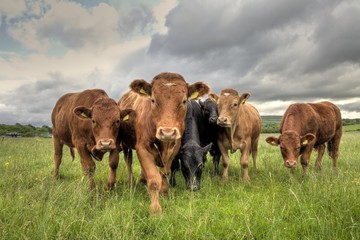This article was originally published by Rhoda Wilson at The Daily Exposé.
The Beef Carbon Reduction Scheme is a new payment support scheme for beef farmers in Northern Ireland. The scheme aims to reduce the maximum age at slaughter of beef cows over a four-year implementation period to “reduce greenhouse gas emissions.”
This scheme has been dictated down by the United Nations which is targeting livestock farming to eliminate chronic hunger.
Northern Ireland’s Beef Carbon Reduction Scheme (the Scheme”) was introduced by the Department of Agriculture, Environment and Rural Affairs (“DAERA”) and opened on 1 January 2024. It will run for four years.
“It has been designed to improve the efficiency of the beef sector and reduce livestock greenhouse gas emissions, thereby contributing to meeting the Climate Change Act (Northern Ireland) 2022 targets,” DAERA states.
The Climate Change Act is legislation that aims to tackle “climate change” by reducing greenhouse gas (“GHG”) emissions. It sets a target of 100% reduction in net zero GHG emissions by 2050, along with interim targets including at least 48% reduction in net emissions by 2030.
As reported by Farming UK, Agriculture Minister Andrew Muir said the opening of the Scheme was a significant milestone in supporting the industry toward greater environmental sustainability. Farming UK went on to quote Muir:
“My department is committed to supporting more environmentally sustainable farming practices that benefit our climate and environment, whilst providing clear incentives to drive better resource efficiency within our agricultural sector.
“This innovative approach signals a shift in how we deliver support to decarbonise and protect our environment, thereby contributing to meeting the targets set by the Climate Change Act (NI) 2022.
“I would encourage farmers to engage with the department on how best to adapt their on-farm practices to meet the targets set for the Scheme and contribute to a more environmentally sustainable and productive sector.”
Beef Carbon Reduction scheme opens today for NI farmers, Farming UK, 15 April 2024
The age of slaughter is due to fall from 30 months now, in year one, to 26 months in 2027. The reduction in the age of slaughter is according to a 2020 proposal made by the National Beef Association (“NBA”), the main lobbying organization for the British beef industry.
According to the NBA the longer a cow lives, the more carbon emissions they are responsible for. So, in 2020, the NBA proposed “a solution to this problem”: kill cows when they are younger – at 27 months instead of the current 30 months typical in the UK – and put a carbon tax on older animals.
Payment rates to Northern Irish farmers under the Scheme had a phased introduction from January – March 2024. The payment rate in January 2024 was £20 per eligible animal, in February 2024, £40, and in March 2024, £60. Since April 2024 onwards the payment rate has been £75 per eligible animal.
As Peter Imanuelsen pointed out: “ In other words, slaughter the cows at a younger age when they have less meat, which will likely make the price of beef go even higher. All in the name of climate change of course.”
Last year, the Irish government proposed culling 200,000 cows to meet climate change targets. Likewise, the Welsh government’s Sustainable Farming Scheme proposals could result in the culling of over 100,000 cows.
Under the scheme, Welsh farmers are currently expected to have to set aside 10 percent of their land for trees and a further 10 percent for wildlife habitat – which farming leaders fear could cause “utter carnage,” “will rip out the heart of the rural economy” and result in 5,500 job losses. It has also led to fears that farmers will be forced to kill tens of thousands of cows to make way for the new land management practices.
As reported by The Epoch Times, according to the Welsh government’s December 2023 report ‘Potential economic effects of the Sustainable Farming Scheme’, overall output losses of £125 million and livestock reductions of 122,000 are estimated, a nearly 11 percent contraction.
However, according to The Scottish Farmer, as of two weeks ago the controversial scheme has been delayed for a year after countrywide protests including several in Powys.
Why are they determined to demonize and destroy agriculture, in particular the beef industry? It all comes down to global diktats handed down by the United Nations (“UN”) which are being developed and formalized further as time goes on.
On 10 December 2023, the UN’s Food and Agriculture Organisation (“FAO”) published a roadmap of its multi-year plan to achieve its “global commitment to transform agrifood systems.”
“We embark on a three-year journey encapsulated in the United Nations Climate Change Conference (COP) 28, COP 29 and COP 30, each step bearing distinct significance in our collective pursuit,” FAO stated introducing its roadmap.
One of FAO’s targets is reducing methane emissions from livestock by 25% by the year 2030 because it will eliminate chronic hunger. Codswallop.


Do they actually believe this psychobabble or are they just hoping we will?
Note that the percentage of “gross GHG emissions” in the second image matches the percentage of “methane emissions from livestock” reduction in the first. They are targeting the livestock sector, specifically, to cut GHG emissions.
“Livestock … is responsible directly for 26 percent of agrifood system emissions (enteric fermentation, manure, etc.),” FAO claims. What a load of codswallop. Nevertheless, the nonsense talk continues:
When comparing the 2020 level to the envisioned scenario in 2030 as outlined in this roadmap, it becomes evident that our proposal aligns with the global methane pledge. Specifically, the reduction in methane emissions within the agrifood system stands at approximately 10 per cent … It’s noteworthy that the collective efforts across the broader economy can contribute additional reductions, working towards the 30 per cent reduction target pledged by countries.
Achieving SDG 2 without breaching the 1.5 °C threshold: A global roadmap Part 1, A first report, part of a multi-year process, Food and Agriculture Organisation, 10 December 2023
The above highlights that our governments are complicit in the UN’s methane reduction plan. Without our authority to do so, our governments have pledged to comply with the UN’s scheme.
FAO gives 9 points of “what to do” about livestock to remedy the problem they have conjured up (see image below). Note point number 6 about “changing the livestock population.”

For those who want to delve deeper into FAO’s multi-pronged assault on livestock farming, its webpage provides the following “to know more” list of resources:
- Five practical actions towards low-carbon livestock
- Methane emissions in livestock and rice systems: Sources, quantification, mitigation and metrics
- Pathways towards lower emissions: A global assessment of the greenhouse gas emissions and mitigation options from livestock agrifood systems
- Livestock emission data at a glance
- Shaping the future of livestock
For an overview of FAO’s scheme, if you can stomach it, below is the FAO chief economist, Maximo Torero Cullen, talking about achieving the UN’s SDG 2 – Sustainable Development Goal 2: Zero Hunger – “without breaching the 1.5 °C threshold.” Sickening as it may be there is an upside; the video at least gives us the face and name of one of the people who is pushing this plan forward and is probably being paid very well to do so.
A roadmap is necessary, Cullen says, because “we are violating six of the nine planetary boundaries … If we don’t start doing and creating this transformation, we will be violating more planetary boundaries and potentially entering into an exponential increase of the frequency of climate events.”
“Planetary boundaries” sounds scary, doesn’t it? Who set these so-called planetary boundaries? In September 2023, a team of 20 “scientists” published a paper that quantified, for the first time, “all 9 planetary boundaries.” The “research” was funded by the European Research Council, the German government, the Carlsberg Foundation, and the Volkswagen Foundation.
So, 20 “scientists” – funded by an EU institution and Germany, which also happen to be large exporters of pharmaceuticals and the largest WHO funders – have decided what the planetary boundaries are. But that’s not all, these 20 people have decided that 6 of their 9 planetary boundaries have been “crossed.” Oh, dear …
The only suggestion we can make to ease their worries is that the EU and UN self-styled “elites” and their 20 scientists catch the next flight to Mars and make a go of it there. Assuming the scientists have not determined that Mars has crossed any planetary boundaries, life will perhaps be more sustainable for them there.











0 Comments